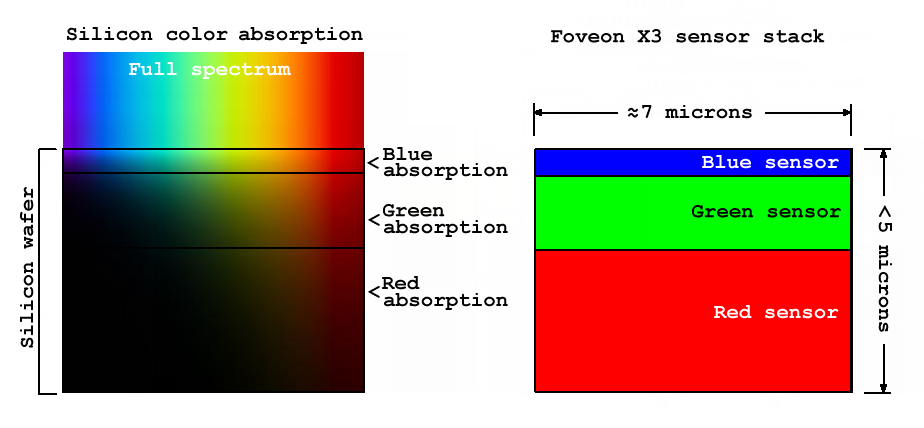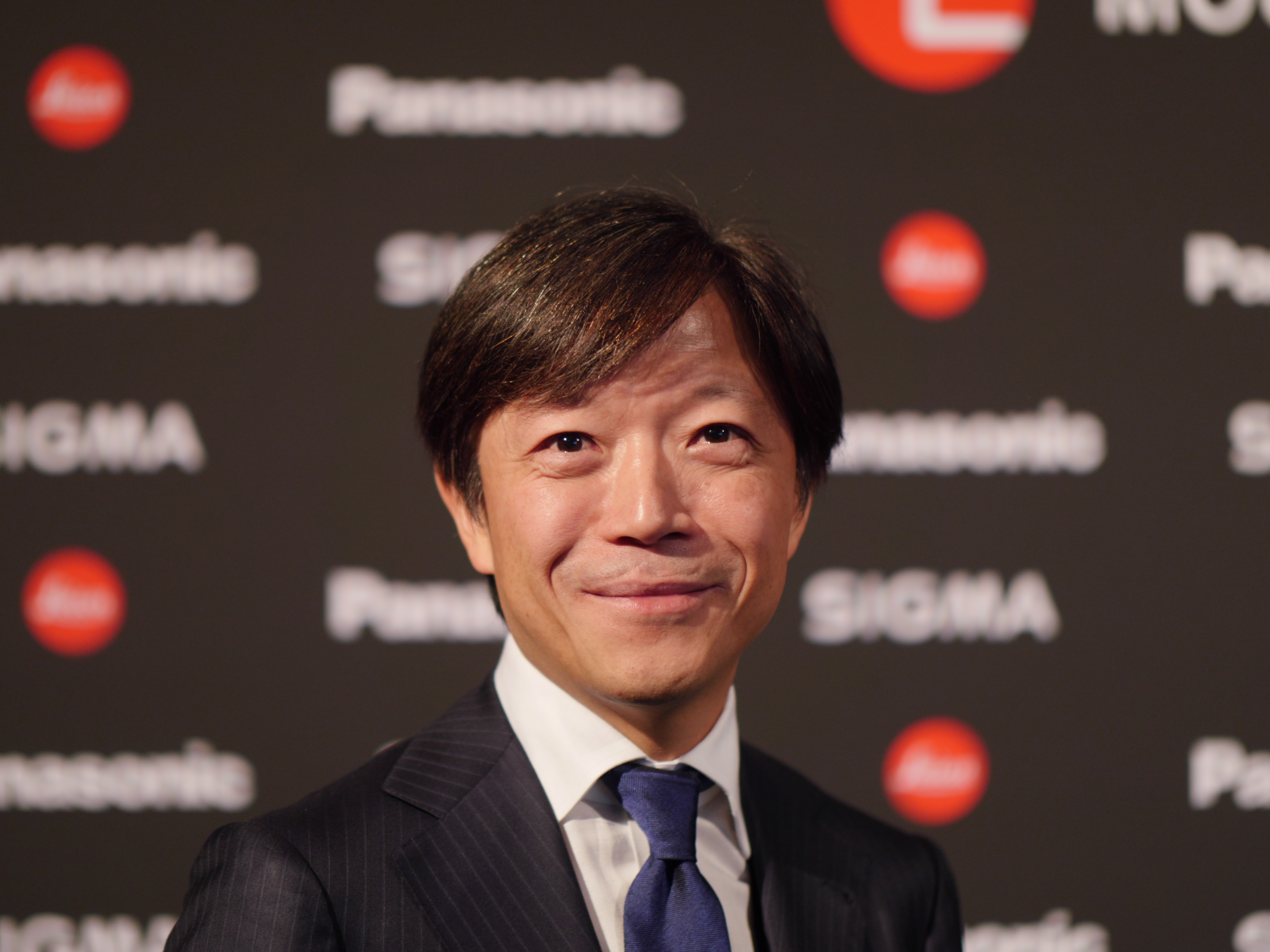|
Sigma SD10
The Sigma SD10 is a digital single-lens reflex camera (DSLR) manufactured by the Sigma Corporation of Japan. It was announced on October 27, 2003, and is an evolution of the previous SD9 model, addressing many of the shortcomings of that camera. The Sigma SD10 cameras are unique in the digital DSLR field in using full-color sensor technology, and in that they only produce raw format images that require post-processing on a computer. Foveon X3 image sensor Like its predecessor, the SD10 uses a sensor with the unique Foveon X3 sensor technology. The 10.2-million-pixel raw file generated from this sensor is processed to produce a 3.4 megapixel size image file. Although the image file is smaller than images from competing 10 megapixel cameras, it is made from the same number of measured data values because the Foveon sensor detects full-color data (three values) at each photosite; the actual resolution contained in its 3.4 MP images is about the same as a conventional Bayer/ ... [...More Info...] [...Related Items...] OR: [Wikipedia] [Google] [Baidu] |
Foveon X3
The Foveon X3 sensor is a digital camera image sensor designed by Foveon, Inc., (now part of Sigma Corporation) and manufactured by Dongbu Electronics. It uses an array of photosites that consist of three vertically stacked photodiodes. Each of the three stacked photodiodes has a different spectral sensitivity, allowing it to respond differently to different wavelengths. The signals from the three photodiodes are then processed as additive color data that are transformed to a standard RGB color space. The X3 sensor technology was first deployed in 2002 in the Sigma SD9 DSLR camera, and subsequently in the SD10, SD14, SD15, SD1 (including SD1 Merrill), the original mirrorless compact Sigma DP1 and Sigma DP2 in 2008 and 2009 respectively, the Sigma dp2 Quattro series from 2014, and the Sigma SD Quattro series from 2016. The development of the Foveon X3 technology is the subject of the 2005 book ''The Silicon Eye'' by George Gilder. Operation The diagram to the right depi ... [...More Info...] [...Related Items...] OR: [Wikipedia] [Google] [Baidu] |
Sigma Corporation
is a Japanese company, manufacturing cameras, lenses, flashes and other photographic accessories. All Sigma products are produced in the company's own Aizu factory in Bandai, Fukushima, Japan. Although Sigma produces several camera models, the company is best known for producing high-quality lenses and other accessories that are compatible with the cameras produced by other companies. The company was founded in 1961 by Michihiro Yamaki, who was Sigma's CEO until his death at age 78 in 2012. Sigma products work with cameras from Canon, Nikon, Pentax, Sony, Olympus and Panasonic, as well as their own cameras. Sigma has also made lenses under the Quantaray name, which have been sold exclusively by Ritz Camera. Similarly, Sigma lenses were sold exclusively by the former Wolf Camera, but following the merger of Wolf and Ritz, both brands can be purchased. Sigma's digital SLRs, the SD9, SD10, SD14 and SD15, plus the latest SD1 are unusual in their use of the Foveon X3 ... [...More Info...] [...Related Items...] OR: [Wikipedia] [Google] [Baidu] |
Bayer Sensor
A Bayer filter mosaic is a color filter array (CFA) for arranging RGB color filters on a square grid of photosensors. Its particular arrangement of color filters is used in most single-chip digital image sensors used in digital cameras, camcorders, and scanners to create a color image. The filter pattern is half green, one quarter red and one quarter blue, hence is also called BGGR, RGBG, GRBG, or RGGB. It is named after its inventor, Bryce Bayer of Eastman Kodak. Bayer is also known for his recursively defined matrix used in ordered dithering. Alternatives to the Bayer filter include both various modifications of colors and arrangement and completely different technologies, such as color co-site sampling, the Foveon X3 sensor, the dichroic mirrors or a transparent diffractive-filter array. Explanation Bryce Bayer's patent (U.S. Patent No. 3,971,065) in 1976 called the green photosensors ''luminance-sensitive elements'' and the red and blue ones ''chrominance-sensiti ... [...More Info...] [...Related Items...] OR: [Wikipedia] [Google] [Baidu] |
Infrared
Infrared (IR), sometimes called infrared light, is electromagnetic radiation (EMR) with wavelengths longer than those of visible light. It is therefore invisible to the human eye. IR is generally understood to encompass wavelengths from around 1 millimeter (300 GHz) to the nominal red edge of the visible spectrum, around 700 nanometers (430 THz). Longer IR wavelengths (30 μm-100 μm) are sometimes included as part of the terahertz radiation range. Almost all black-body radiation from objects near room temperature is at infrared wavelengths. As a form of electromagnetic radiation, IR propagates energy and momentum, exerts radiation pressure, and has properties corresponding to both those of a wave and of a particle, the photon. It was long known that fires emit invisible heat; in 1681 the pioneering experimenter Edme Mariotte showed that glass, though transparent to sunlight, obstructed radiant heat. In 1800 the astronomer Sir William Herschel discove ... [...More Info...] [...Related Items...] OR: [Wikipedia] [Google] [Baidu] |
CR-V3
A CR-V3 battery (sometimes CRV3) is a type of disposable high-capacity 3-Volt battery used in various electronic appliances, including some digital cameras. It has the shape and size of two side-by-side AA batteries. This allows CR-V3 batteries to function in many (though not all) devices originally designed for only AA batteries. An RCR-V3 battery is a rechargeable 3.7 V lithium-ion battery. Disposable CR-V3 batteries Often, a CR-V3 battery is a single cell based on a non-rechargeable lithium battery chemistry, with a nominal voltage of 3 V (the same as 2 alkaline AA batteries). Duracell Ultra CR-V3 is composed of two 3 V AA sized lithium cells connected in parallel. Because both lithium and lithium-ion chemistries offer higher energy density than NiMH rechargeable batteries or even alkaline batteries, a CR-V3 battery is designed to last much longer than a pair of AA batteries. Some more recent CR-V3 batteries are composed of 2 lithium AA rechargeable batt ... [...More Info...] [...Related Items...] OR: [Wikipedia] [Google] [Baidu] |
List Of Battery Sizes
This is a list of the sizes, shapes, and general characteristics of some common primary and secondary battery types in household, automotive and light industrial use. The complete nomenclature for a battery specifies size, chemistry, terminal arrangement, and special characteristics. The same physically interchangeable cell size or battery size may have widely different characteristics; physical interchangeability is not the sole factor in substituting a battery. The full battery designation identifies not only the size, shape and terminal layout of the battery but also the chemistry (and therefore the voltage per cell) and the number of cells in the battery. For example, a CR123 battery is always LiMnO2 ('Lithium') chemistry, in addition to its unique size. The following tables give the common battery chemistry types for the current common sizes of batteries. See Battery chemistry for a list of other electrochemical systems. Cylindrical batteries Rectangular batteries ... [...More Info...] [...Related Items...] OR: [Wikipedia] [Google] [Baidu] |
Sigma AF Mount
Sigma (; uppercase Σ, lowercase σ, lowercase in word-final position ς; grc-gre, σίγμα) is the eighteenth letter of the Greek alphabet. In the system of Greek numerals, it has a value of 200. In general mathematics, uppercase Σ is used as an operator for summation. When used at the end of a letter-case word (one that does not use all caps), the final form (ς) is used. In ' (Odysseus), for example, the two lowercase sigmas (σ) in the center of the name are distinct from the word-final sigma (ς) at the end. The Latin letter S derives from sigma while the Cyrillic letter Es derives from a lunate form of this letter. History The shape (Σς) and alphabetic position of sigma is derived from the Phoenician letter ( ''shin''). Sigma's original name may have been ''san'', but due to the complicated early history of the Greek epichoric alphabets, ''san'' came to be identified as a separate letter in the Greek alphabet, represented as Ϻ. Herodotus reports that "san" ... [...More Info...] [...Related Items...] OR: [Wikipedia] [Google] [Baidu] |
EF Lens Mount
The EF lens mount is the standard lens mount on the Canon EOS family of SLR film and digital cameras. EF stands for "Electro-Focus": automatic focusing on EF lenses is handled by a dedicated electric motor built into the lens. Mechanically, it is a bayonet-style mount, and all communication between camera and lens takes place through electrical contacts; there are no mechanical levers or plungers. The mount was first introduced in 1987. Canon claims to have produced its 100-millionth EF-series interchangeable lens on 22 April 2014. History The EF mount replaces its predecessor, the FD mount. The standard autofocus lens mounting technology of the time used a motor in the camera body to drive the mechanics of the focus helicoid in the lens by using a transfer lever. The key innovation of the EF series was to use a motor inside the lens itself for focusing. This allowed for autofocusing lenses which did not require mechanical levers in the mount mechanism, only electrical con ... [...More Info...] [...Related Items...] OR: [Wikipedia] [Google] [Baidu] |
Adobe Photoshop CS2
Adobe Photoshop is a raster graphics editor developed and published by Adobe Inc. for Microsoft Windows, Windows and macOS. It was originally created in 1988 by Thomas Knoll, Thomas and John Knoll. Since then, the software has become the industry standard not only in raster graphics editing, but in digital art as a whole. The software's name is often colloquially used as a verb (e.g. "to photoshop an image", "photoshopping", and "photoshop contest") although Adobe discourages such use. Photoshop can edit and compose raster images in multiple layers and supports Mask (computing), masks, alpha compositing and several color models including RGB color model, RGB, CMYK color model, CMYK, CIELAB, spot color, and duotone. Photoshop uses its own PSD and PSB file formats to support these features. In addition to raster graphics, Photoshop has limited abilities to edit or render text and vector graphics (especially through clipping path for the latter), as well as 3D graphics and video. ... [...More Info...] [...Related Items...] OR: [Wikipedia] [Google] [Baidu] |




